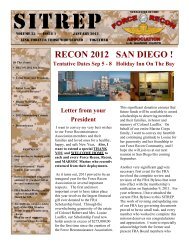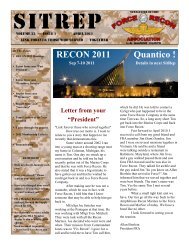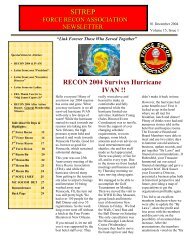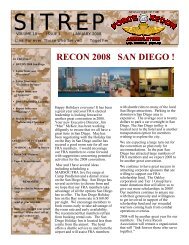Det One - Force Recon Association
Det One - Force Recon Association
Det One - Force Recon Association
You also want an ePaper? Increase the reach of your titles
YUMPU automatically turns print PDFs into web optimized ePapers that Google loves.
4<br />
DET ONE<br />
* If it appears that both documents took pains to state and restate<br />
conclusions in a ponderous manner, consider that the language<br />
was not used loosely. “Complementary,” “specialized,” “unique,”<br />
and “maritime” were all employed in a manner calculated to state<br />
accurately what the Marine Corps should and should not do.<br />
itive effect for the Corps as a whole; and that the<br />
Corps could develop a full-spectrum capability in<br />
consonance with current joint definitions. The report<br />
concluded that the Marine Corps should develop a<br />
specialized maritime strike capability based on existing<br />
doctrine; that this capability had to be in line with<br />
the needs of amphibious command relationships; that<br />
any Marine special operations force had to be complementary<br />
to existing naval special operations organizations;<br />
and finally, that the development of this<br />
capability was a crucial matter, given the world’s<br />
prevalent threats. 14<br />
The recommendation of the Fleet Marine <strong>Force</strong> Atlantic<br />
report was that the Marine Corps develop a “viable<br />
special operations capability in order to provide<br />
fleet commanders a ‘total response’ capability.” The<br />
three steps needed to achieve this goal were to develop<br />
an “updated maritime special operations doctrine;”<br />
to provide “additional, standardized training”<br />
for the air-ground task forces; and to create a “dedicated<br />
special operations force within FMFLant and<br />
FMFPac to conduct specialized missions requiring<br />
highly skilled forces.” The study group’s preferred<br />
option for an enhanced Marine amphibious unit and<br />
a large, dedicated special operations force of Type-A<br />
capability survived in a somewhat altered form; a different<br />
version of it was later offered as one course of<br />
action to the Commandant. The updated doctrine in<br />
the FMFLant report and additional standardized training<br />
were fully in line with the study group’s second<br />
option. *<br />
The final paragraph of the report’s cover letter portended<br />
a significant change in Marine Corps training,<br />
organization, and capabilities: “The conclusions, recommendations,<br />
and implementation proposals, if approved,<br />
require an extensive effort to develop a<br />
unique and viable potential that exists within our current<br />
MAGTF structure. FMFLant is prepared to immediately<br />
initiate and develop this potential.” 15<br />
The Commandant Decides<br />
On 27 April 1985, Lieutenant General Gray met<br />
with General Kelley to review the special operations<br />
study group’s findings and Gray’s Fleet Marine <strong>Force</strong><br />
Atlantic report. They discussed three options for proceeding<br />
with Marine Corps special operations enhancements.<br />
The first was to make no change, clearly<br />
not an acceptable alternative given Secretary of Defense<br />
Weinberger’s guidance. The second was to “develop<br />
a dedicated special operations force,” while the<br />
third was to “make the fleet Marine forces capable of<br />
conducting a wide spectrum of special operations<br />
with their conventional forces.” 16<br />
Given that Lieutenant General Gray had stated that<br />
his command was prepared to take action “immediately”<br />
on the issue, it is not surprising that he came<br />
with detailed proposals. Gray’s preferred course of<br />
action for a dedicated special operations force was<br />
to create a 1,000-man Marine air-ground task force<br />
complete with ground and aviation combat elements.<br />
He included a timeline for its training cycle, a list of<br />
its overall capabilities, and a scheme for a test bed<br />
unit to validate the concept. The plan for the test unit<br />
was a smaller version of the larger force, a unit of<br />
289 men, with the ground combat element being a<br />
reinforced Marine rifle company and the aviation element<br />
made up of four CH-53D or E helicopters. The<br />
pros and cons of the plan echoed what the II Marine<br />
Amphibious <strong>Force</strong> study group and the Fleet Marine<br />
<strong>Force</strong> Atlantic report had stated: the dedicated special<br />
operations unit would provide a substantial capability,<br />
but it would have significant costs in time, money,<br />
and negative impacts on the Marine Corps’ missions<br />
and structure. 17<br />
Lieutenant General Gray also had an alternative<br />
plan: take what the Marine Corps had and improve it.<br />
This plan had two goals. The first was to “standardize/improve<br />
a Marine amphibious unit’s capability to<br />
conduct doctrinal special operations.” The second<br />
was to “avoid conflict with missions of other services’<br />
special operations forces.” To address the first goal, a<br />
third Marine amphibious unit would be established<br />
within II Marine Amphibious <strong>Force</strong>. Training cycles<br />
were to be expanded and standardized and the three<br />
units would be set into a sustained rotation, ensuring<br />
that one was overseas as Landing <strong>Force</strong> Sixth Fleet,<br />
one was training to take over that mission, and one<br />
was reorganizing for its training cycle, having just returned<br />
from deployment. A notional chart showed<br />
this plan at work, with continuous deployments<br />
graphed out into late 1989 and specific units earmarked<br />
for service. “The Solution,” as the brief called<br />
it, continued with specifics for training improvements,<br />
including but not limited to “command and<br />
staff planning and execution skills required for special<br />
operations;” “development of infantry company/platoon<br />
skills necessary to provide a raiding<br />
force assault element, covering element, or reserve<br />
element;” and “development of aviation skills necessary<br />
for penetration/covert approach, urban operations,<br />
and withdrawal.” The plan provided for a<br />
broad and valuable capability, enhanced training






